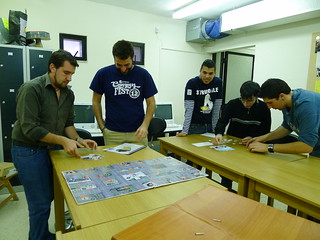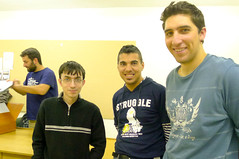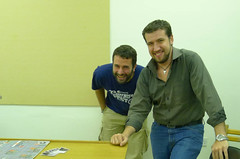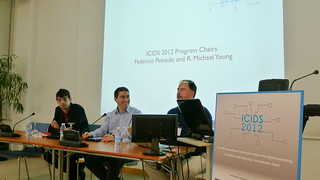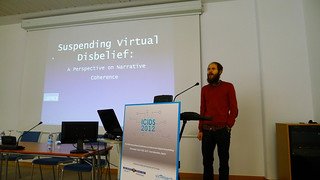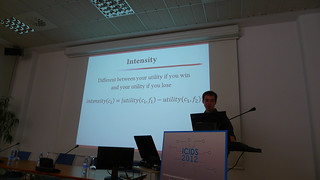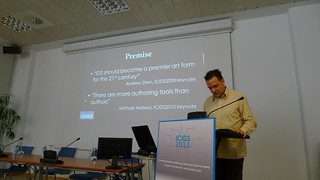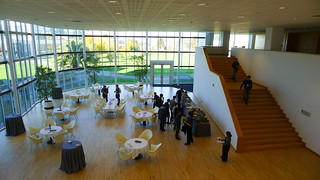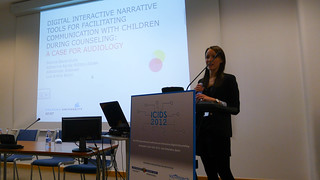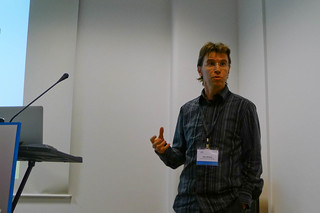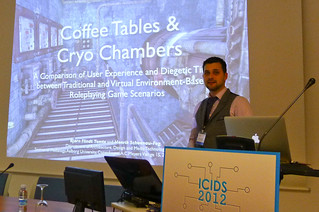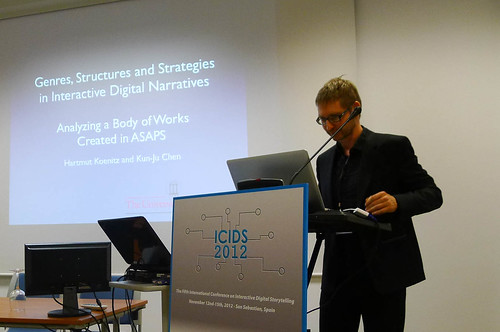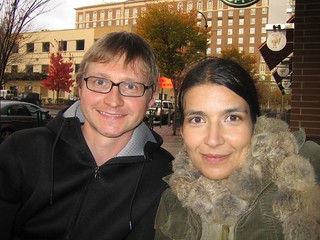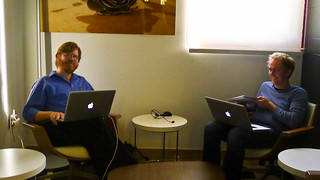This fall I
have been teaching a study unit on Game Design at our Masters in Digital Game
at the University of Malta. This is the first year we teach the course, and we
are starting with a small group of students. We can be flexible and find individual
solutions in case our structure isn't optimal this first time around. Except me
teaching at the masters' there is Rilla Khaled who teaches game design with me,
there is Gordon Calleja and Costatino Oliva who teaches game analysis, and
there is Georgios Yannakakis who, together with two teachers from ICT, teaches
computing science for game development. We also have a fourth strand in the
masters, which is commercialization and project management. This is taught by
industry professionals, this year by the CTO of TRC.
I have been
teaching game design and related subject since 2004, but somehow it always
feels like it is the first time. During the summer of 2012 I planned this
introductory course in game design, but as soon as got hold of the students'
contact details I sent out a survey to them to get an idea about previous
experience in both the playing of games and of developing them.
This is the
short description of the course:
"The
course address the role of the game designer, the structure of games, how to
work with formal elements as well as dramatic, and ways to approach system
dynamics. Students work in groups and conceptualize and prototype smaller
games."
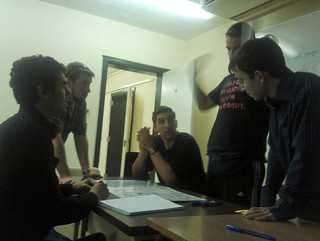

Concerns
I had
several concerns while I was planning the course. How to balance theory and
practice? Were to begin - which topics need we start with, and which can wait?
How do we make sure the group dynamics work out? And what about creating a safe
environment for experimentation despite that their work is graded?
I'll go
through my main concerns, listing them, and describe how I aimed to solve them.
Then, I'll tell you how it went!
- What to teach them - where do I start, and in
what order should I place the content?
I decided
to use a course book as a basic skeleton for the course. I had, unconsciously,
already decided to use Tracy Fullerton's book Game Design Workshop, but just in
case I would like to change my mind I browsed through the rest of my design
library. I stuck with Fullerton's book because it is the one that put most
weight on prototyping and play-testing, and does so in a very concrete way.
This agrees with how I like to work in design. As recommended reading I added
chapters from other books for certain topics, such as Bates' chapters on what
project documents are useful in game productions.
Also on the
list of recommended reading is Brathwaite's “Challenges
for Game Designers”.
It has an excellent and condensed introduction chapter defining important terms and approaches. The remainder of the book contains design challenges/exercises for different types of games and game contexts.
Another one is Koster's "A Theory of Fun". This book has had a large impact on the vocabulary used in the area of game design. Koster just gave a speech at GFC Online (October 2012) taking the perspective of "ten years after" - that is, ten years after the publication of the book. The slides for the talk are here: http://www.raphkoster.com/
Yet another great book on game design is Schell's The Art of Game Design: A book of lenses. If I had not used Fullerton's Game Design Workshop as the main course book I would have used this one.
It has an excellent and condensed introduction chapter defining important terms and approaches. The remainder of the book contains design challenges/exercises for different types of games and game contexts.
Another one is Koster's "A Theory of Fun". This book has had a large impact on the vocabulary used in the area of game design. Koster just gave a speech at GFC Online (October 2012) taking the perspective of "ten years after" - that is, ten years after the publication of the book. The slides for the talk are here: http://www.raphkoster.com/
Yet another great book on game design is Schell's The Art of Game Design: A book of lenses. If I had not used Fullerton's Game Design Workshop as the main course book I would have used this one.
- How to
achieve a balance between theory and practice? Students need the practice to appreciate the
theory, and they need the theory when working practically. (This is something
Jesse Schell have been blogging about too)
I had seven
seminars and seven workshops to work with. Part of the first one would go to
overview and introduction, and the end would be the final seminar. I considered
what they absolutely HAVE to know about the design, and what they MUST learn to
do and think about when designing. I plucked those topics, and then added
workshops where they would apply the knowledge in the topics. This meant that I
was not using the order in Fullerton's book, but I could still use the full
chapters for different seminars.
Given the large
amount of time that it would take for the students to complete the assignments
they needed to do in order to practice game design I aimed to only add the absolutely
necessary texts as reading assignments. Besides the selected chapters in Fullerton's
book I only added two texts as mandatory reading: one about Hunicke and LeBlanc's
MDA model and the other about Dorman's Machination framework.
In the
first seminar the students got to choose from the course literature about which
texts to champion. This text, they would in one of the seminars present to
their co-students and prepare a discussion about.
There is a list of the topics we had at the seminars, and a list of
workshops and assignments in the end of this post.


- How do I make sure that they early get
practical experience of designing different types of games? (There is a risk of individuals
getting so immersed in one idea or problem that they do not want to focus on
anything else.)
It turned
out that this particular group of students all were graduated computing
scientists and many of them had partaken in game development projects. I
decided that even though they would be able to create digital prototypes from
start, I would encourage them to stay with pen and paper. This way they would
be able to quickly try several different designs, and they wouldn't get
distracted by coding problems. During the first three weeks they prototyped
three different games. Then, they got to choose one of them to develop further.
This game was play-tested and iterated for three more weeks. I hoped that this would help them to have
their focus on the core design as well as on the experience their certain
design might result in for the player.
- How do I cater for good group dynamics in the
student groups? (Or at least be prepared to sort out things if it becomes
terrible.)
I planned
for having two occasions for group division. In the first seminar I divided
them into two groups using coin flips, thus making a random group division.
Then, after having made their first three game designs they would be able to
change groups for the second half of the course. This would make sure that if
two persons who for some reason cannot work out their differences would be able
to change groups. In the one of the game design exercises a beginning task was
to fill in a Meyers-Briggs Personality test - I added it in as part of the
exercise so that they might use personality properties of some kind of system
as part of the design of a game that contains characters. I hoped for a
secondary effect where they would be aware of each other's strengths as
individuals when working in groups. In my experience shortcomings of others are
easier to accept and overcome when one have concrete knowledge (or some kind of
belief or interpretation) of others strengths.
- On Malta, student's work is graded. How would I make sure to create an environment where student feel that they can be creative, where they take risks, and where they are not mentally frozen by performance anxiety?
I divided
the assignments I gave into those that would be graded and not graded. All the
design exercises except the final deliveries were to stay without grade. At the
same time, the final deliveries would report on and be a result on what they
had been producing during the course. But then, they would have been able to
pick one of three designs they liked best, and had been able to iterate that
design several times.
How it went
I have the
impression that the course went well. The students had a 100% attendance. They
delivered 100% of their assignments, and not a single one of them was late. For
me this is the very first time that has happened. The group of students was very
small, and they all had responsibilities in the seminars, so that could have been
a reason. But still: Highscore! They also volunteered for extra work, and went
the extra mile of doing the extra exercises. When the students had handed in their final
assignments (an individual short-paper, a production report, a game design document
and a game prototype) I was quite impressed by their work. They had managed to
create games, describe how they did it, showing that they had understanding for
the process. I had played the games with a colleague the day before the
seminar, so I could get them some feedback on that too. Next year I'll schedule
more time for playing the students' games though, in order to get time to
explore all features. For their individual short papers I had asked them to
define an important design problem and give suggestions for how to explore the
same. Here, they all had picked very
interesting and relevant topics, which we spent most of the last seminar
discussing these.
Ending discussion
I had
created an online survey for the students to fill in, but some topics I wanted
to ask them about face to face. In the last seminar we spent half an hour
discussing the course. What had worked and what had not worked?
It seems that the balance between theory and
practice had worked well - the students had recognised that they were, in the
workshop, practising the same skills and topics they had been discussing in the
seminar the same day.
The workload
seems to have been fairly well adjusted. I was worried that I had given them
too much (see list of assignment and bear in mind that they had 3 other courses
running in parallel). But they had appreciated the incremental nature of the
workload, that they got week-sized chunks of work, and then one week to
assemble the work into their final deliveries. They also said that they liked
to have this 4 hour marathon (2 hours seminar, 2 hours workshop) rather than
dividing their day. I had been worried about that too.
They were
generally happy with the clarity of instruction, but would have wanted to learn
more about table top RPGs before getting the task of designing one. Next year
that could be a part of assignments.
They had
really appreciated the guest lecturer from TRC, Jade Pecorella, who talked
about how game design is communicated and documented in the projects where she
works as a designer.
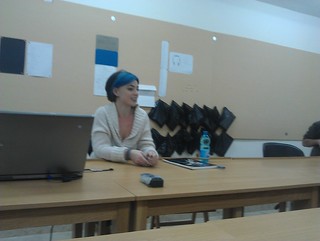

They had
also liked the way they were each championing parts of the course materials, so
that (no offence they hastened to say) not only the professor talks all the
time, and that it is easier to learn when one has to explain to someone else.
It was
difficult to squeeze out something negative of them, but that's what the
anonymous survey is for. I told them to think about it as a play-test. If I
don't know what's wrong, I can't fix it.
The next
course I will teach will be focussed on AI based game design and prototyping/sketching
tools and methods. I really look forward to it. I need to make sure that even
if this group are all computing scientists I need to design a course that is
meaningful and useful for non-computing scientists too. By the way, there is a
quite common understanding that computing scientists or 'coder types' would be
less creative than others. This is wrong. Not that we would be MORE creative.
Just that we are just as creative as the rest of the population. At least, this
is my belief after having witnessed the process of game creation in this group
that consists only of computing scientists. (Also - take a poet. Teach her how
to program. Will she be less creative when she has more knowledge?)
***************************************************************
List of topics
The list below is presented in the order they appear
in the course.
Brainstorming
and Conceptualization methods
The role of
the game designer
The
structure of games
Prototyping
methods
Formal
Elements
MDA - a
formal Approach to Game Design and Research (paper)
Working
with Dramatic Elements
Play
testing
System
Dynamics
Functionality,
Completeness and Balance
Simulating
Mechanics to Study Emergence (paper on Machinations)
Revisiting
Brainstorming and Conceptualization (creativity in the long run discussion)
Game Design
Document (Communicating Game Design)
*****************************************************************
List of mandatory Assignments
Presenting
chapters from the course book and papers to the seminar (in seminar and
assignment) (graded)
Brainstorming
Exercises (in workshop) (not-graded)
Writing my
first treatment (assignment) (not-graded)
Making my
first paper prototype (in workshop & assignment) (not graded)
Modifying a
Battleship Prototype (in workshop) (not graded)
Making a
Table top role-playing game prototype (in workshop and assignment) (not graded)
The first
play-testing and writing a play test-script (assignment) (not graded)
Play-testing
using the other group as testers (in workshop) (not graded)
Writing the
game design document (in workshop and as assignment) (graded)
Writing
your production report (assignment) (graded)
Finalizing
your prototype for delivery (assignment) (graded)
Writing
your short-paper (assignment) (graded)
The text
seminar - presenting and questioning a colleague's text. (At the end of the
course) (not-graded)
